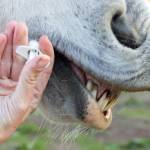Parasite Resistance to Equine Dewormers

Resistance is defined as a measurable decrease in the efficacy of a compound against a population of worms that were previously susceptible. Resistance is not due to any change in the drug, but rather to genetic adaptations by the target parasites. How does resistance develop? Genes for resistance traits occur naturally at extremely low levels, but frequent treatments and exclusive use of one drug class provide certain advantages.
Whenever resistant worms survive treatment, they are able to continue reproducing in the absence of competition from susceptible worms, and the resistant genotype becomes more frequent in the population.
Continued and frequent use of the same class of drug ultimately results in a predominance of resistant genotypes in the population.
Traditionally, many horse owners “rotate” dewormers, meaning they alternate among the available chemical classes. Rotation was originally implemented to cover deficient spectra of the available anthelmintics, not to thwart resistance. Rotation per se is no longer as important as ensuring that all anthelmintics used are still effective.
Resistance to certain drug classes (e.g., benzimidazoles) is alarmingly prevalent, but by no means universal. Therefore, it behooves practitioners and/or horse owners to determine which drug classes are still effective in a herd, and which should be avoided in the future.
The changing patterns of resistance among target nematodes lend an element of urgency to implementing major changes in parasite control strategies for horses in the U.S. The most critical change will be in the attitudes of horse owners and equine veterinarians.
New recommendations and justifications will provide effective control, will decrease selection pressure for the development of anthelmintic resistance, and may accomplish both at a lower cost than current, inefficient practices.
Read more from Advances in Equine Nutrition IV.
Related reading:








